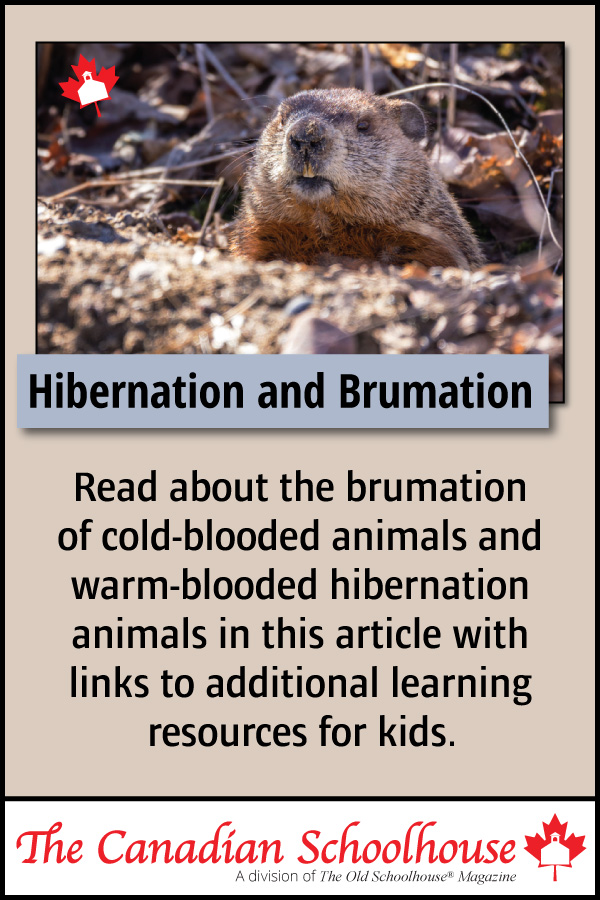
Winter brings many changes to the world. When temperatures drop, we tend to make changes that help us adapt to the temperature change. For instance, as humans, we tend to spend more time inside, wear layers of clothing, eat heavier more hearty meals, etc. For many animals, these changes are more drastic. Many animals go into a state of lessened activity, their metabolisms decline, breathing is at a slower rate, and their body temperature drops.
For warm blooded animals (endothermic), hibernation is a way to conserve energy during the winter months when food is sparse. The animal’s metabolism and body temperature drops conserving energy for the days, weeks and months ahead.
For cold blooded animals (ectothermic), this process is called brumation. Brumation brings lethargy and rest. During brumation, the animal may not move for the duration of the cold season. During brumation, animals will find a place in their habitat that is insulated. They may also wake on warmer days to find food and water. Because ectothermic animals cannot change their body temperature, this is a different process than hibernation.
In order to make it through hibernation or brumation, animals eat large amounts of food, ensuring they have enough energy in their internal storage to make it through the hibernation period. They then begin their hibernation “rest,” and their body uses the fat storage to keep the animal alive for the period of hibernation, which can be days, weeks or many months.
How Animals Use Hibernation or Brumation to Survive
Groundhogs
Groundhogs hibernate for up to five months, dropping their body temperature to 37˚F. Their heart rate goes down to five to ten beats per minute and their breathing to sixteen breaths per minute. At the end of their hibernation period, groundhogs will have lost up to ¼ of their body weight.
Wood Frogs
Wood frogs go through brumation. During brumation, a wood frog’s body will be 35-45% frozen for up to eight months each year. Their heart stops beating, and they do not breathe. Their body produces glucose that prevents the cells from freezing on the inside and keeps the frog hydrated. When they wake from their winter “freeze,” they are energized and ready for spring.
Garter Snakes
Brumation for garter snakes is a group process. Most garter snakes brumate in dens filled with dozens to hundreds of snakes. These dens can be found in trees, logs, rocks, under roads or in buildings. Many garter snakes do not eat during the eight month hibernation period.
Chipmunks
While chipmunks do not truly hibernate, they go into a hibernation-like state for days at a time. During their torpor (suspended activity), their heart rate decreases, and their body temperatures drop. They will be motionless for this period as well. But unlike true hibernators, they wake every few days to eat.

Box Turtles
Box turtles go through brumation for three to eight months. As it senses that brumation will begin soon, a box turtle will lower its food intake to begin a fasting state. During brumation, a turtle needs no food and only water to survive.
Bumblebees
While not all bees hibernate, bumblebee queens can hibernate up to nine months. Each fall, the bumblebee colony dies, with the exception of the many queens. Each queen mates then finds a hole in the ground or another small opening for the winter. After hibernation, she finds a new nest in spring and begins to make her home. She lays her eggs, and a new colony begins.
Ground Squirrels
For four to nine months, ground squirrels will go without food or water. Their body temperature will drop to the temperature of the surrounding soil, and their heart rate, metabolism, and breathing will slow dramatically.
Bats
During the winter, bats choose to hibernate or migrate. If hibernation is chosen, the bat will drop their heart rate to ten beats per minute and can go more than a minute without taking a breath. Their body temperature drops to almost freezing, and their bodily functions slow down to reduce energy. Their torpor can last for a few hours or months depending on their habitat.
Common Poor-will
As the only bird known to hibernate, the Common Poor-will chooses to hibernate instead of migrating. As winter approaches, the Poor-will finds a hollow log or patch of grass to make its home. Poor-wills go weeks or months without eating. They drop their temperature to as low as 40˚F, their respiration can be undetectable, and their heart rate will drop to ten beats per minute.
There are many other animals that use hibernation or brumation during the winter, and there are even some in warmer climates that take some time to go through estivation (hibernation in hot weather). Each species has a different way of handling extreme temperatures for survival. The way animals adapt to the changing temperatures is God’s way of helping them survive.
There are some great science experiments and more information on the Home Science Tools to increase your understanding of hibernation and brumation.
Science News for Kids has a great article on hibernation as well as some videos and pictures of hibernation to help your understanding as well.
This year, as you prepare for winter, think a bit more about the way the animals around you are preparing as well. Watch closely as the number of animals you see in your backyard decreases. Look for ways the animals are preparing for their long winter hibernation, migration or brumation. Then in spring, watch as the animals begin to emerge again.
This article has been written by homeschooling staff writers of The Canadian Schoolhouse (TCS). Enjoy more of our content from TCS contributors and staff writers by visiting our Front Door page that has content on our monthly theme and links to all our content sections.





















